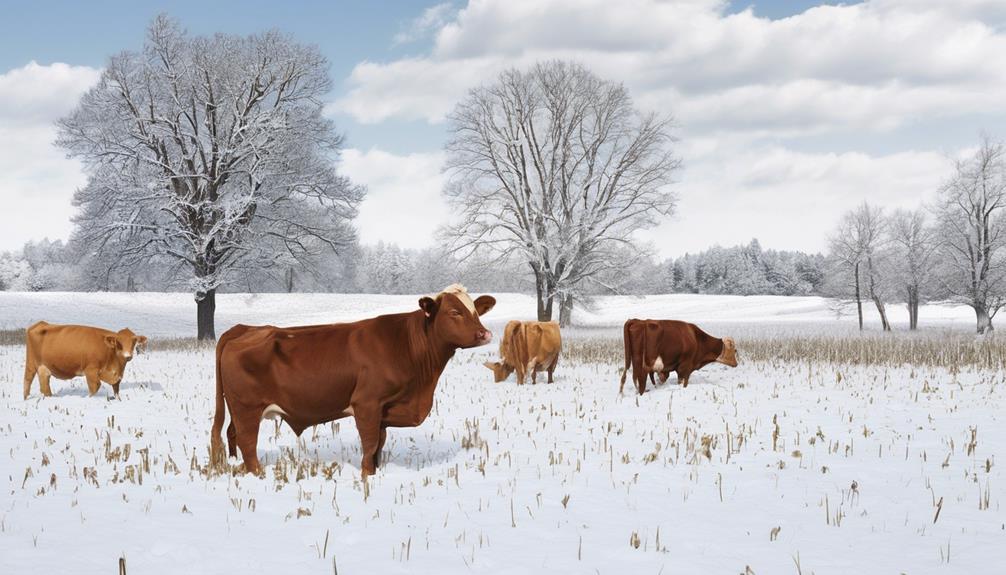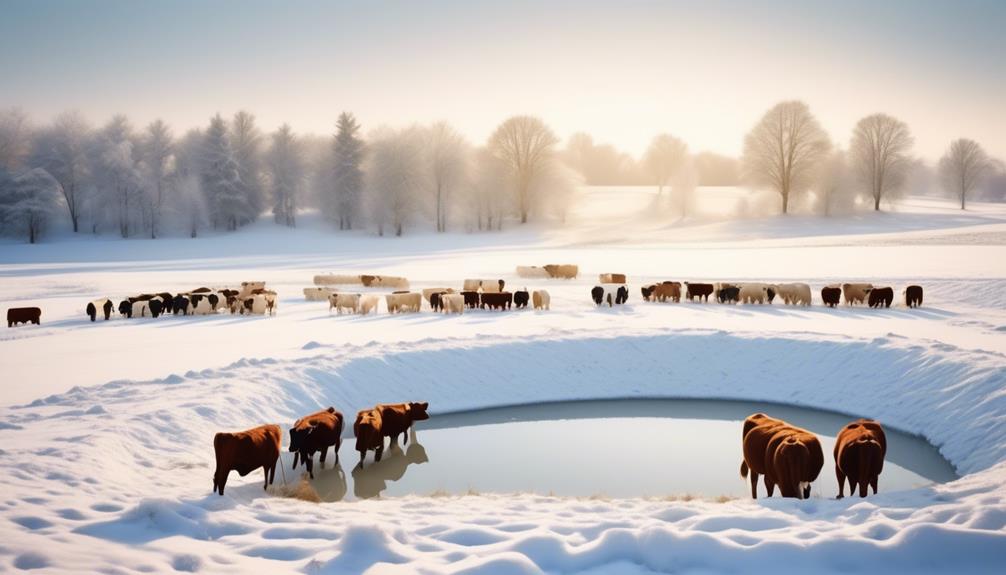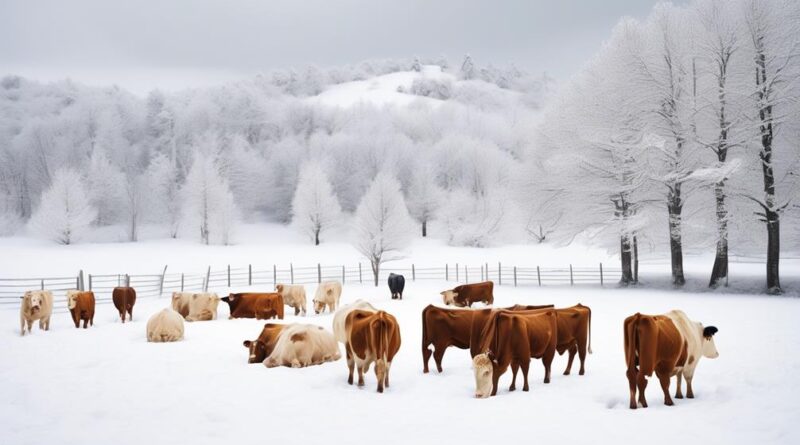Effective Winter Grazing Techniques for Cattle Herds
Are you prepared to ensure that your cattle herds have adequate grazing and nutrition during the winter months?
Effective winter grazing techniques are crucial to the health and productivity of your herd. By implementing strategic practices, you can maximize forage utilization, minimize feed costs, and maintain the overall well-being of your cattle.
Let's explore the key considerations and techniques that can help you navigate the challenges of winter grazing for your herd.
Winter Forage Options

Consider planting cool-season annuals such as rye, wheat, and oats to provide an abundant and nutritious winter forage option for your cattle herd. These crops can be grazed directly or harvested for winter haylage and silage options. They not only offer a valuable source of nutrition for your herd during the winter months but also contribute to the overall health and productivity of your cattle.
When it comes to winter haylage, planting winter annuals like rye can be an excellent choice. These can be harvested at the right stage of maturity to produce high-quality haylage for your cattle. By planning and planting these crops strategically, you can ensure a sustainable winter forage option that meets the nutritional needs of your herd.
In addition to haylage, silage options can also be explored to provide a reliable winter forage source for your cattle. Crops such as oats and wheat can be harvested and ensiled to create nutritious silage that can be stored and fed to your herd throughout the winter. This allows you to have a consistent supply of forage regardless of the weather conditions or other external factors.
Shelter and Windbreak Considerations
For effective protection against harsh winter conditions, ensuring adequate shelter and windbreaks for your cattle herd is essential. When it comes to shelter design, consider the following factors to provide the best possible protection for your herd:
- Size and Orientation: Construct shelters that are spacious enough to accommodate the entire herd, allowing them to move comfortably without feeling cramped. Orient the shelters to block prevailing winds and maximize solar gain during the day, providing a warm and sheltered environment for the cattle.
- Material Selection: Utilize durable and insulating materials for the shelters to provide effective protection against cold temperatures. Proper insulation can help retain heat and create a comfortable microclimate within the shelter, keeping your cattle warm and healthy.
- Ventilation: Ensure adequate ventilation within the shelters to prevent moisture buildup, which can lead to health issues for the cattle. Proper airflow is essential for maintaining air quality and preventing the accumulation of harmful gases.
- Accessibility: Design shelters with easy access points for the cattle to enter and exit without difficulty. Additionally, consider the placement of feed and water sources within the shelter to ensure that the cattle have access to essential resources without being exposed to the harsh winter elements.
When it comes to windbreak placement, strategic positioning is crucial to provide optimal protection for your herd:
- Natural Features: Utilize natural features such as tree lines or topography to create natural windbreaks that offer effective protection from harsh winds.
Feeding and Supplement Strategies

To optimize winter grazing for your cattle herd, implementing effective feeding and supplement strategies is essential for maintaining their health and productivity.
When it comes to feed storage, it's crucial to ensure that your feed is stored in a manner that preserves its quality. Proper storage methods, such as using airtight containers or silos, can help prevent spoilage and maintain the nutritional value of the feed throughout the winter months. Additionally, regularly inspecting feed storage areas for signs of mold or moisture can help mitigate potential issues and ensure that your cattle are receiving high-quality feed.
Supplements play a vital role in supporting the nutritional needs of your cattle during the winter season. It's important to evaluate the effectiveness of the supplements you provide to ensure they're meeting the specific dietary requirements of your herd. Conducting regular assessments of your cattle's health and consulting with a veterinarian or nutritionist can help determine if adjustments to the supplement strategy are necessary. This proactive approach can help address any deficiencies and contribute to the overall well-being of your herd.
Monitoring Body Condition
Regularly assess your cattle's body condition to ensure they're maintaining optimal health and productivity during the winter grazing season. Monitoring body condition is crucial for managing the nutritional needs and weight of your cattle. Here are some key points to consider:
- Body Condition Scoring: Regularly assess your cattle's body condition using a standardized scoring system. This will help you track changes in their weight and body condition over time, allowing you to make necessary adjustments to their diet and management practices.
- Nutritional Monitoring: Keep a close eye on the nutritional content of the forage available to your cattle during the winter grazing season. Understanding the nutritional value of the forage will help you make informed decisions about supplementation and ensure that your cattle receive the necessary nutrients to maintain their body condition.
- Weight Management: Monitor your cattle's weight regularly to ensure that they're neither gaining nor losing too much weight. Sudden weight loss can be a sign of nutritional deficiencies, while excessive weight gain may indicate overfeeding or insufficient exercise.
- Health Checks: In addition to body condition scoring and weight management, schedule regular health checks for your cattle. This will help you identify any underlying health issues that could impact their body condition and overall well-being.
Water Access and Management

Assessing your cattle's body condition and nutritional needs during the winter grazing season naturally leads to the critical consideration of water access and management for optimal herd health. In cold climates, it's essential to prevent water sources from freezing over. Implementing heating elements in watering systems or using insulated tanks can help prevent ice formation, ensuring your cattle have continuous access to water. Regularly checking and maintaining these systems is crucial to avoid any issues during freezing temperatures.
Additionally, managing snowmelt and runoff is vital for maintaining water access. Positioning watering points away from areas prone to heavy snow accumulation or strategically placing barriers can prevent contamination and ensure water availability. It's important to regularly monitor these areas to address any potential issues promptly.
Efficient water management is essential for the health and productivity of your herd during the winter grazing season. By implementing ice prevention measures in watering systems and effectively managing snowmelt and runoff, you can ensure that your cattle have access to clean, unfrozen water. This, in turn, supports their overall health and well-being during the colder months.
Regular maintenance and proactive management of water sources are key components of successful winter grazing techniques for your cattle herd.
Grazing Rotation Planning
Considering the diverse nutritional needs of your cattle herd, effective grazing rotation planning is crucial for optimizing their forage intake and overall health during the winter months. By implementing a well-thought-out grazing schedule and pasture management, you can ensure that your cattle receive the necessary nutrients and maintain good health throughout the winter.
Here are some key aspects to consider when planning your grazing rotation:
- Forage Quality: Ensuring a consistent supply of high-quality forage in each grazing area can positively impact your cattle's overall health and productivity.
- Rest Periods: Allowing for adequate rest periods between grazing cycles can promote the regrowth of pastures, contributing to sustainable forage availability for your herd.
- Health Monitoring: Regularly rotating your cattle to fresh grazing areas can help mitigate the risk of parasite infestations and reduce the incidence of diseases associated with overgrazing.
- Environmental Sustainability: Proper pasture management not only benefits your cattle but also contributes to the long-term health of the land, promoting biodiversity and soil health.
Ensuring Adequate Nutrition

As you plan your winter grazing rotation for your cattle herd, ensuring adequate nutrition is essential for maintaining their health and productivity during the colder months. Feed quality plays a crucial role in providing the necessary nutrients for your cattle during winter grazing. It's important to assess the nutritional content of the feed available in your grazing area. Consider conducting a forage analysis to determine the levels of protein, energy, fiber, and other essential nutrients. This will help you supplement any deficiencies and ensure your cattle receive a balanced diet.
Additionally, grazing duration is a key factor in ensuring adequate nutrition for your cattle during winter. With limited daylight hours and colder temperatures, the grazing duration may need to be adjusted. Monitor the time your cattle spend grazing and ensure they've access to high-quality forage during this period. If the grazing duration is limited due to weather conditions, consider providing supplemental feed to meet their nutritional requirements. This could include hay, silage, or other stored forage options.
Health and Disease Prevention
To ensure the health and productivity of your cattle herd during winter grazing, prioritize disease prevention and maintaining their overall well-being. This is crucial for the well-being and success of your herd.
Here are some essential steps to keep your cattle healthy and disease-free during the winter months:
- Regular Veterinary Check-ups: Regular check-ups by a qualified veterinarian can help identify any health issues early on and ensure that your cattle are in optimal health. This can provide peace of mind and ensure that your cattle are receiving the best care possible.
- Vaccination Protocols: Implementing a comprehensive vaccination program is vital in protecting your herd from common winter illnesses. Vaccines are a crucial tool in preventing infectious diseases and can significantly reduce the risk of outbreaks within your herd.
- Parasite Control: A robust parasite control program is essential for maintaining the health of your cattle. Parasites can thrive in winter conditions and pose a significant threat to the well-being of your herd. Implementing effective parasite control measures can help prevent health issues and maintain productivity.
- Nutritional Supplementation: Ensuring that your cattle receive adequate nutrition during the winter months is essential for their overall health and disease resistance. Providing nutritional supplements can help bolster their immune system and support their overall well-being.
Frequently Asked Questions
How Can I Prevent My Cattle From Damaging Winter Grazing Areas?
To prevent your cattle from damaging winter grazing areas, use effective fencing techniques and practice rotational grazing. Rotate your cattle to different grazing areas periodically and use sturdy fencing to control their access and prevent overgrazing.
What Are Some Alternative Options for Winter Forage if My Usual Choices Are Unavailable?
If your usual winter forage choices are unavailable, consider sustainable alternatives to support grazing management and soil health. Look into cover crops, crop residues, or hay as potential options to ensure your cattle have adequate nutrition during the winter months.
What Are Some Signs That My Cattle May Be Experiencing Stress From Winter Weather Conditions?
You can recognize stress in your cattle during winter by observing changes in behavior, appetite, and body condition. Handling nutrition is crucial to support them through harsh conditions, ensuring adequate feed and access to clean water.
How Can I Minimize the Risk of Illness in My Cattle During the Winter Months?
To minimize illness risk in your cattle during winter, consider winter vaccinations and shelter options. Winter vaccinations can boost immunity, while providing different shelter options can protect your herd from harsh weather conditions, reducing the risk of illness.
Are There Any Specific Considerations for Managing Grazing Areas in Areas With Heavy Snowfall?
When managing grazing areas in heavy snowfall regions, it's crucial to implement effective snow management and grazing rotation strategies. By doing so, you can ensure that your cattle have access to fresh forage and minimize damage to the grazing areas.
Conclusion
In conclusion, implementing effective winter grazing techniques for your cattle herds is crucial for their health and well-being.
By considering forage options, shelter and windbreaks, feeding and supplement strategies, monitoring body condition, water access, grazing rotation planning, nutrition, and health prevention, you can ensure your herd thrives even in the winter months.
With careful planning and management, you can maintain a healthy and productive cattle operation year-round.
